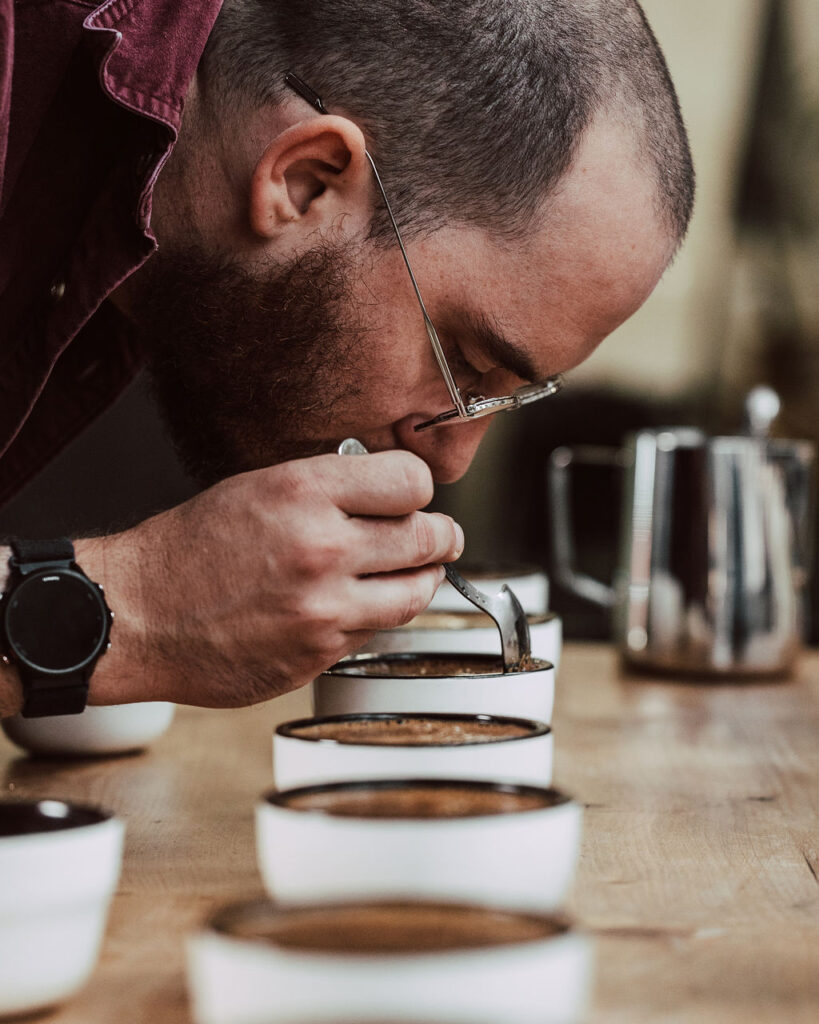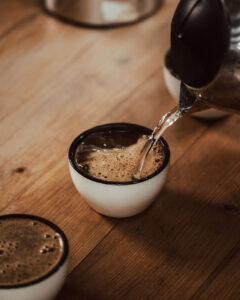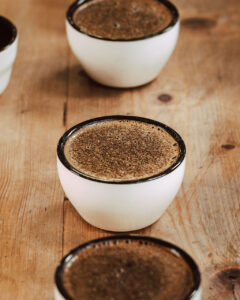Ever had a coffee that made you pause mid-sip? That’s no accident. But how do we spot those game-changing beans before they hit the mug?
The answer lies in coffee cupping – a process made specifically by the coffee industry to measure quality and understand what makes each set of beans special. At Beanworks, it’s a key part of how we make sure the beans we roast are packed with bold flavour.
Let’s take a look at how it works.
Why Cup Coffee?
So, why all the slurping? Because cupping is how coffee professionals, from green coffee buyers to baristas, gets to know their beans inside out.
For coffee roasters like us at Beanworks, a cupping session is how we compare coffees from different origins side by side and fine-tune our roast profiles.
Quality Control
Coffee cupping is also a big deal in quality control. We use it to flag inconsistencies, check if a coffee’s improved (or not), and make sure everything is hitting the mark. The Specialty Coffee Association (SCA) even sets global standards for it, with evaluation forms that give you a coffee cupping score. You can learn more about this in our blog: “What is Speciality Coffee?”

In short, cupping is how the coffee world speaks a common language, and whether you’re roasting, brewing, or sipping, it’s your best chance to really listen to what those coffee beans have to say.
Beanworks’ Coffee Cupping Guide
Ready to give it a try? This beginner’s guide breaks down everything you need to get started, from essential kit to slurping like a seasoned pro.
Equipment Needed
• Cupping spoons, or use an alternative like soup spoons
• Glasses or bowls that can hold at least 150ml of water
• A timer
• A grinder
• A set of scales
• A kettle
• A pen and paper
And of course, the coffee itself – you’ll want to have a couple of different types so that you can compare them, and 20g of each


How To Cup Coffee: Step-by-Step
Here’s how we do it…
1. Grind the coffee
Start by grinding 2g of your first coffee sample before grinding the other 18g. This helps prevent cross contamination from other coffees and keeps your flavour notes nice and clean.
2. Weigh out the coffee
Weigh out 8.25g of the coffee sample for every 150ml of water your cup or bowl holds. To work this out, divide the amount your cup or bowl holds by 150 and then multiply it by 8.25. For example, if your cup holds 200ml, you’ll want to measure out 11g of coffee. Once you’ve weighed out the correct amount, pop the sample into its bowl and label it.
3. Repeat for the other samples
Follow the same process as above for your other coffee samples until all of your bowls are prepared.
4. Smell the dry aroma
Lean in and give the beans a good sniff. Do they remind you of berries? Flowers? Cocoa powder? Note your observations down – this is your first introduction to what’s coming.
5. Brew time
Boil the kettle, pour the hot water over each sample, and set your timer for 4 minutes. A crust will rise up on the top – and trust us, it’s where the magic starts. Now be strong. Don’t touch. Just wait.
6. Break the crust
Once the timer hits, it’s time to break through that crust with your spoon. All you need to do is push through it three times. As you do, breathe in – this is the wet aroma, and it’s packed with new layers of scent. Take a moment to notice what’s changed, then note it down.
7. Scoop
Use two spoons to remove the foam and any remaining coffee grounds from the surface. This clears the way for your first sips and helps improve clarity when drinking.
8. Let the coffee cool
Just a little more waiting. Let the coffee cool for around 10 minutes so you’re not just tasting hot water. This is where real flavour shows up.
9. Time to slurp
Here’s the fun bit. Take a spoonful and slurp like you mean it. This spreads the brew all over your tongue, helping you pick up on the texture, body, and full flavour range – from nutty, chocolate, or caramel tones to zesty acidity or gentle sweetness.
Taste again as it cools more and notice how the flavours change.
10. Keep your palate fresh
Trying multiple coffees? Don’t forget to spit – seriously. Taking in too much caffeine can mess with your palate and skew what you’re picking up.
11. Rinse and repeat
Rinse each bowl (and spoon) between rounds to prevent cross contamination. Clean tools = clean flavour.
Mistakes to Avoid When Coffee Cupping
Cupping’s all about tuning into the details, and a few small slips can really throw things off. Here’s what to watch out for:
- Inconsistent coffee cupping grind size: If your grind size changes between samples, it’ll make your brews harder to compare. Keep it consistent to keep things fair.
- Not cupping frequently enough: The more you do it, the more your palate grows. Cupping regularly helps you dial in on what you love (and what you don’t), and makes it easier to decide what flavours truly excite you.
- Skipping the aroma stage: Don’t miss out on the dry and wet aromas – they’re key to the full picture. The scent of the grounds before and after the pour tells you loads about what’s to come. Give both stages a proper sniff and note them down.
Using Coffee Cupping in Sample Roasting to Find Gold
Felix, our Head of Coffee, is always on the hunt for new standout beans – so green coffee suppliers send through sample packs, usually 100g at a time. Ideal for a couple of 50g roasts: just enough to get a feel for the bean’s potential.

When he’s gathered a collection of exciting new samples, he’ll fire up his headphones and the IKAWA Pro50 sample roaster. Don’t let the size of the machine fool you – they’re built for precision. Felix keeps a bank of roast profiles saved to IKAWA’s software on his phone: a toolkit of graph lines and curves that lets him experiment with roasts from light to super dark.
The samples themselves can be a mix of commercial-grade and speciality coffees from all corners of the globe, each with a different story to tell. Once roasted, the real test begins. Side by side, he’ll cup the coffees: evaluating aroma, acidity, sweetness, balance – comparing potential, and (hopefully) finding something magic.
It’s here, in this stage, that we decide what’s worth chasing. Because every great coffee we roast starts out as tiny beans of possibility.
Ready to Taste Speciality Coffee That Hits Different?
Now that you know how to cup like the coffee pros, why not put that palate to the test? Our roasters bring out the best in each bean, so every brew fills your mouth with something truly delicious.
Craving Something New?
Explore our speciality coffee beans rangePick up a few bags, and see which ones light up your mouth with bold notes of chocolate, caramel, fruit, or florals.
Then come back to our blog for more articles and coffee discoveries – there’s always something new to learn from our awesome coffee roasters.

